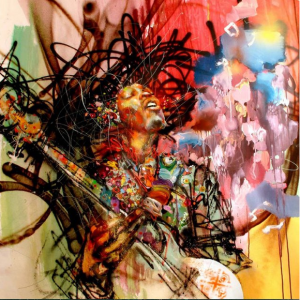Talk of a half-hour wait circulated through the line extending down the block. The rumor was true. Opening nights for Fifty24SF are almost always densely packed with art-goers. The crowd usually ranges from early twenties to late thirties. They spill from the small gallery onto the sidewalk and collect in tiny groups to smoke and chat. However, the extensive line for the opening of David Choe’s Character Assassination exhibit is not usual for the Lower Haight gallery. A few hipster girls, lucky enough to make it inside, were pointing and yaysaying their decided favorites. The intimacy of the gallery allows Choe to create a salon style atmosphere. On the left wall works span from ceiling to floor. If there weren’t so many people, the largest piece would be the first thing a viewer sees when walking through the door. On the right wall, two larger works are flanked by smaller pieces. Works are hung in an almost haphazard manner. Haphazardness being a trait Choe is known for.
Misadventures have been plentiful in the life of this thirty-four-year-old Korean-American artist. Choe grew up in Los Angeles and travels extensively. He was once lost in the Congo for two weeks at the age of nineteen. Years later, he landed himself a three-month stint in a Japanese prison, after a tussle with an undercover officer. The chaos and energy evident in Choe’s exploits find their way into his work, which adorn the offices of Facebook and, oh yes, the White House.
Quick and dirty, that’s how Choe works. Spray paint, oil, watercolor, pencil, anything he can get his hands on is applied with a furious energy. He works loose and finishes by tightening up the figures exploding with color. Seductive women are his primary focus. Robots take a close second. His mostly textural approach counters the minute cartooned faces and cityscapes casually rendered and penciled in around the edges. In one large painting entitled “Ignored Prayers,” which takes up most of the small gallery’s back wall and is an amalgam of oil, acrylic, wax crayons and spray paint on canvas, cars, buildings and rottweilers sit within scrambled hair atop the placid face of a beautiful woman.
The gallery walls are painted black with characters scrolled in white graffiti. This is distracting because the walls conflict with artwork hanging on them. Even though Choe is known for chaos, it’s overkill.


